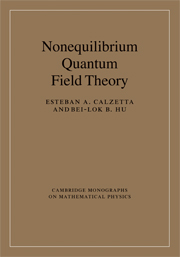Book contents
- Frontmatter
- Contents
- Preface
- I FUNDAMENTALS OF NONEQUILIBRIUM STATISTICAL MECHANICS
- II BASICS OF NONEQUILIBRIUM QUANTUM FIELD THEORY
- 4 Quantum fields on time-dependent backgrounds: Particle creation
- 5 Open systems of interacting quantum fields
- 6 Functional methods in nonequilibrium QFT
- III GAUGE INVARIANCE, DISSIPATION, ENTROPY, NOISE AND DECOHERENCE
- IV THERMAL, KINETIC AND HYDRODYNAMIC REGIMES
- V APPLICATIONS TO SELECTED CURRENT RESEARCH
- References
- Index
4 - Quantum fields on time-dependent backgrounds: Particle creation
from II - BASICS OF NONEQUILIBRIUM QUANTUM FIELD THEORY
- Frontmatter
- Contents
- Preface
- I FUNDAMENTALS OF NONEQUILIBRIUM STATISTICAL MECHANICS
- II BASICS OF NONEQUILIBRIUM QUANTUM FIELD THEORY
- 4 Quantum fields on time-dependent backgrounds: Particle creation
- 5 Open systems of interacting quantum fields
- 6 Functional methods in nonequilibrium QFT
- III GAUGE INVARIANCE, DISSIPATION, ENTROPY, NOISE AND DECOHERENCE
- IV THERMAL, KINETIC AND HYDRODYNAMIC REGIMES
- V APPLICATIONS TO SELECTED CURRENT RESEARCH
- References
- Index
Summary
Beginning with this chapter we will introduce quantum field theory (QFT) and develop the necessary ideas and methods which form the basis of nonequilibrium (NEq) QFT. We focus on quantum field systems in external fields or in a time-varying background spacetime. The latter is included here because many basic concepts and techniques in QFT in external fields were developed historically in the area of QFT in curved spacetimes, especially in time-dependent backgrounds used in relativistic cosmology. Cosmology is also the arena where some of the basic tenets of NEqQFT were established and tested out.
In a dynamical background some basic concepts of QFT need to be reexamined. We point out the problem in straightforwardly extending the methodology of Minkowski spacetime QFT, such as the definition of particles by way of instantaneous diagonalization of the Hamiltonian. The vacuum state defined this way is nonviable since particles are being created as the system evolves. We introduce the Bogoliubov transformation between two sets of mode functions of the field, and discuss how two different particle models defined at different times are related to each other. Particle creation is a nonadiabatic process. We introduce the nth order adiabatic vacuum and number state as the proper way to construct a QFT in dynamical backgrounds. We derive expressions for spontaneous particle production as parametric amplification of vacuum fluctuations, and stimulated production as amplification of particles already present in the quantum or thermal state.
- Type
- Chapter
- Information
- Nonequilibrium Quantum Field Theory , pp. 93 - 147Publisher: Cambridge University PressPrint publication year: 2008

